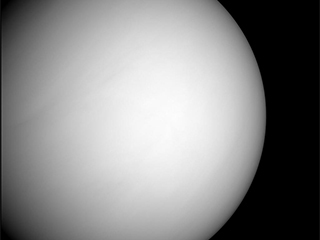News | August 5, 2020
Giant Cloud Disruption, Unnoticed for 35 Years, Discovered on Venus

The MESSENGER spacecraft snapped a series of images as it approached Venus on June 5, 2007.
NASA’s IRTF telescope has contributed to a study unveiling the mysteries of a planetary-scale cloud discontinuity periodically lashing the depths of the thick clouds of Venus since at least 1983. This article was contributed by the researcher who led the study, Javier Peralta, a researcher with JAXA Institute of Space and Astronautical Science.
In the cloudy heavens of Venus, an enormous atmospheric disruption, not yet seen elsewhere in the solar system, has been rapidly propagating about 30 miles (50 kilometers) above the hidden surface, remaining unnoticed for at least 35 years. Its discovery is reported in a study published in Geophysical Research Letters.
Venus is often called Earth's sister planet because of similarities in size, mass, density and volume. However, the Venusian environment and the atmosphere are entirely different from those of Earth. The surface of Venus is the hottest in the solar system at a searing 870° F (465 °C) – hot enough to melt lead. The atmosphere, consisting mostly of carbon dioxide with cloud of droplets of sulphuric acid, is about 90 times as thick as that of the Earth's and displays various phenomena unobserved for other planets in the solar system.
The newly discovered phenomenon, the atmospheric disruption, can sometimes extend as far as 4,700 miles (7,500 kilometers), across the equator, from 30º north to 40º south, and occurs in the deeper clouds at altitudes between 30 and 35 miles (47.5 and 56.5 kilometers) above the surface. Recently discovered is that since at least 1983 this wall of acid clouds is periodically swiping the solid globe in five days, at about 205 miles per hour (328 kilometers per hour).
The study was led by Javier Peralta, ITYF researcher at the Japanese space agency JAXA, who first spotted what looked like an atmospheric wave, but of planet-size proportions. This was hinted at in the infrared images of great detail taken by the Venus orbiter Akatsuki (JAXA) during 2016, and by Eliot F. Young and Mark A. Bullock using NASA’s Infrared Telescope Facility (IRTF) on Mauna Kea (Hawaii). The telescope images probed the middle and lower layers of the atmosphere, when Akatsuki could not track this phenomenon any more due to a failure in the onboard infrared cameras.
While other giant cloud patterns have been observed in the atmosphere of Venus, such as the “Y wave” or the 10,000 kilometer-long bow-shaped stationary wave in the upper clouds, this is the first serious candidate for planetary wave at low altitudes. The deep region in the atmosphere where this new disruption was discovered is responsible for the rampant greenhouse effect that makes Venus the hottest world among the planets in the solar system. Planetary-scale waves might help establish a link between the surface and the dynamics of the Venusian atmosphere as a whole, which is still a mystery.
“Provided that this disruption is not visible at 43 miles (70 kilometers) height where the cloud tops are, confirming its wave nature would be of critical importance," Peralta said. "We may have finally found a wave able to transport momentum and energy from the deep atmosphere (precisely where NASA’s Pioneer Venus probes found that Venus stores most of the atmospheric angular momentum) to the upper clouds where it would dissipate. It would, therefore, bring momentum precisely up to the level where we observe the fastest winds of the atmospheric super-rotation of Venus, whose mechanisms have been a long-time mystery.”
This research also reveals that the disruption is associated with important changes in the transparency of the Venusian clouds and the distribution of atmospheric aerosols. Nevertheless, the biggest surprise came when Peralta and his collaborators confirmed the presence of the same features while revisiting images taken as far back as 1983, evidencing a quasi-permanent phenomenon unnoticed for decades. Ongoing observations of Venus’ lower and middle clouds by the IRTF are crucial for confirming that this phenomenon persists as a quasi-permanent feature and for studying its long-term evolution. These are especially important for extending Venus observations after the demise of the IR2 infrared camera on Akatsuki.
The nature of this long-lasting discontinuity and the likely mechanism that ignited and maintains it with cycles of varying intensity are still unknown. Authors’ simulations with the Institut Pierre‐Simon Laplace general circulation model suggest that this disruption may be the physical manifestation of an atmospheric wave of Kelvin type generated below the clouds and propagating, trapped about the equator. “This atmospheric disruption is a new meteorological phenomenon, unseen on other planets. Because of this it is yet difficult to provide a confident physical interpretation,” Peralta adds, “but we do not have doubts that its cyclical effects over the clouds’ properties and distribution of atmospheric aerosols are key pieces missing to complete the complex puzzle of Venus.”
Follow-up observations with NASA’s IRTF in Hawaii and the Nordic Optical Telescope (NOT) in the Canary Islands were recently undertaken coordinated with observations from space with the Akatsuki orbiter, with the hope of providing new hints for understanding the motion of Venus’ atmosphere.

